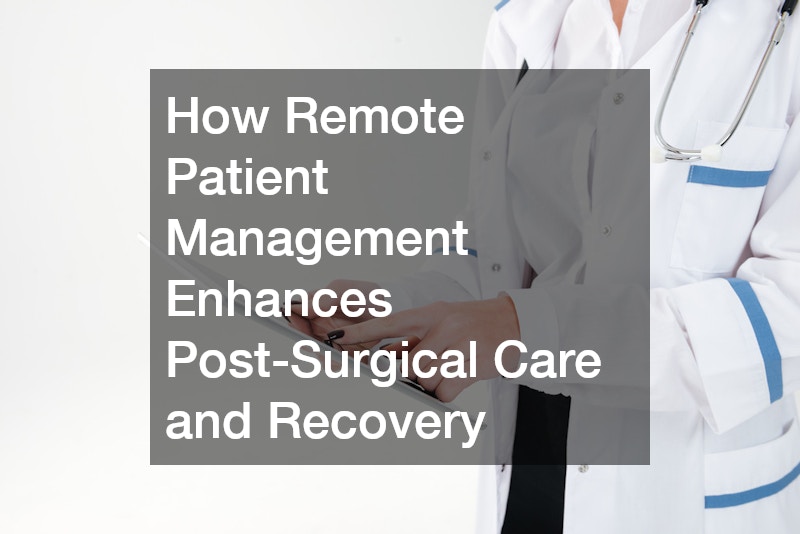Post-surgical care and recovery are critical phases for patients after undergoing surgery. Proper monitoring and timely interventions are necessary to ensure a smooth recovery and to prevent complications. Traditionally, patients would have to attend follow-up appointments, often requiring physical travel and time-consuming visits. However, with advancements in healthcare technology, remote patient management (RPM) has emerged as a transformative solution that enhances post-surgical care, offering a more seamless and effective way to monitor patients.
By leveraging a remote patient monitoring platform, healthcare providers can keep a close eye on patients’ progress in real time, ensuring that any issues are promptly addressed.
In this article, we’ll explore the various ways remote patient management is reshaping post-surgical care, leading to better outcomes and faster recoveries.
Continuous Monitoring for Timely Interventions
One of the most significant benefits of remote patient management in post-surgical care is the ability to continuously monitor patients in real time. After surgery, certain vital signs, such as heart rate, blood pressure, oxygen levels, and temperature, must be closely tracked. Any abnormalities in these indicators can signal complications, such as infection or adverse reactions.
With a remote patient monitoring platform, healthcare providers can monitor these key health indicators 24/7, allowing them to detect early signs of distress. If an anomaly is identified, medical staff can quickly intervene, either through virtual consultations or by arranging immediate medical attention. This continuous oversight ensures that issues are addressed before they escalate, reducing the risk of post-surgical complications.
Personalized Care Plans
Post-surgical care often requires tailored approaches based on the type of surgery and the patient’s individual needs. Remote patient management platforms can facilitate the creation and monitoring of personalized care plans. Based on real-time data, healthcare providers can adjust medication, recommend specific exercises, or alter recovery protocols to better suit the patient’s evolving condition.
For instance, a patient recovering from orthopedic surgery might be prescribed specific physical therapy exercises, which can be tracked through remote monitoring. The patient’s adherence and progress can be assessed in real-time, allowing the care team to provide encouragement or modify the exercise routine as needed. This personalized approach promotes faster recovery while minimizing complications.
Reduction in Hospital Readmissions
One of the greatest challenges in post-surgical recovery is the risk of hospital readmissions due to complications or poor adherence to recovery plans. Remote patient management significantly reduces this risk by ensuring that patients are closely monitored from the comfort of their homes.
Many post-surgical complications, such as infections, can develop unnoticed by the patient, only to be detected when symptoms worsen. With continuous remote monitoring, early warning signs can be caught, allowing healthcare providers to intervene early and avoid a return to the hospital. This not only enhances patient safety but also reduces the financial burden associated with readmissions.
Enhanced Communication Between Patients and Healthcare Providers
Effective communication between patients and healthcare providers is crucial for successful post-surgical care. With remote patient management, communication is streamlined through digital tools, ensuring that patients remain connected to their care teams.
A remote patient monitoring platform allows patients to report symptoms, ask questions, and receive advice without the need for in-person visits. This is ideal for patients who live in remote areas and have limited access to healthcare facilities. It also provides peace of mind to patients, knowing that their healthcare team is just a click away, ready to assist if needed.
Improved Patient Compliance
Post-surgical recovery often requires strict adherence to treatment protocols, including medication schedules, physical therapy, and lifestyle modifications. However, patients may struggle with compliance, either due to forgetfulness or misunderstanding of the recovery plan. Remote patient management helps bridge this gap by providing patients with reminders, alerts, and virtual check-ins to ensure they follow their prescribed recovery plan.
Through the remote patient monitoring platform, patients can receive real-time reminders to take their medication or perform specific exercises. The platform can also track adherence and report any missed activities to healthcare providers, allowing them to follow up with patients and provide support when necessary. This level of accountability helps patients stay on track with their recovery, ultimately leading to better outcomes.
Convenience and Comfort for Patients
For patients, recovering from surgery at home can be far more comfortable than an extended hospital stay. Remote patient management allows patients to recuperate in the familiarity and comfort of their own homes, while still receiving comprehensive medical care.
This not only improves the patient’s emotional well-being but also reduces the strain on healthcare facilities. Hospital beds can be freed up for more critical cases, while post-surgical patients can continue their recovery under supervision remotely. Patients also benefit from reduced travel and waiting times, making the recovery process more convenient overall.
Conclusion: The Future of Post-Surgical Care
As healthcare continues to evolve, remote patient management stands out as a powerful tool in improving post-surgical care and recovery. By leveraging real-time data through a remote patient monitoring platform, healthcare providers can deliver continuous, personalized care while reducing the risk of complications and readmissions.
The combination of enhanced monitoring, improved patient compliance, and seamless communication makes remote patient management an essential component of modern healthcare. As more healthcare systems adopt these technologies, patients and providers alike will experience the benefits of faster, safer, and more convenient post-surgical recoveries.
The future of post-surgical care is undoubtedly digital, and remote patient management will play a pivotal role in ensuring better outcomes for patients worldwide.
.



